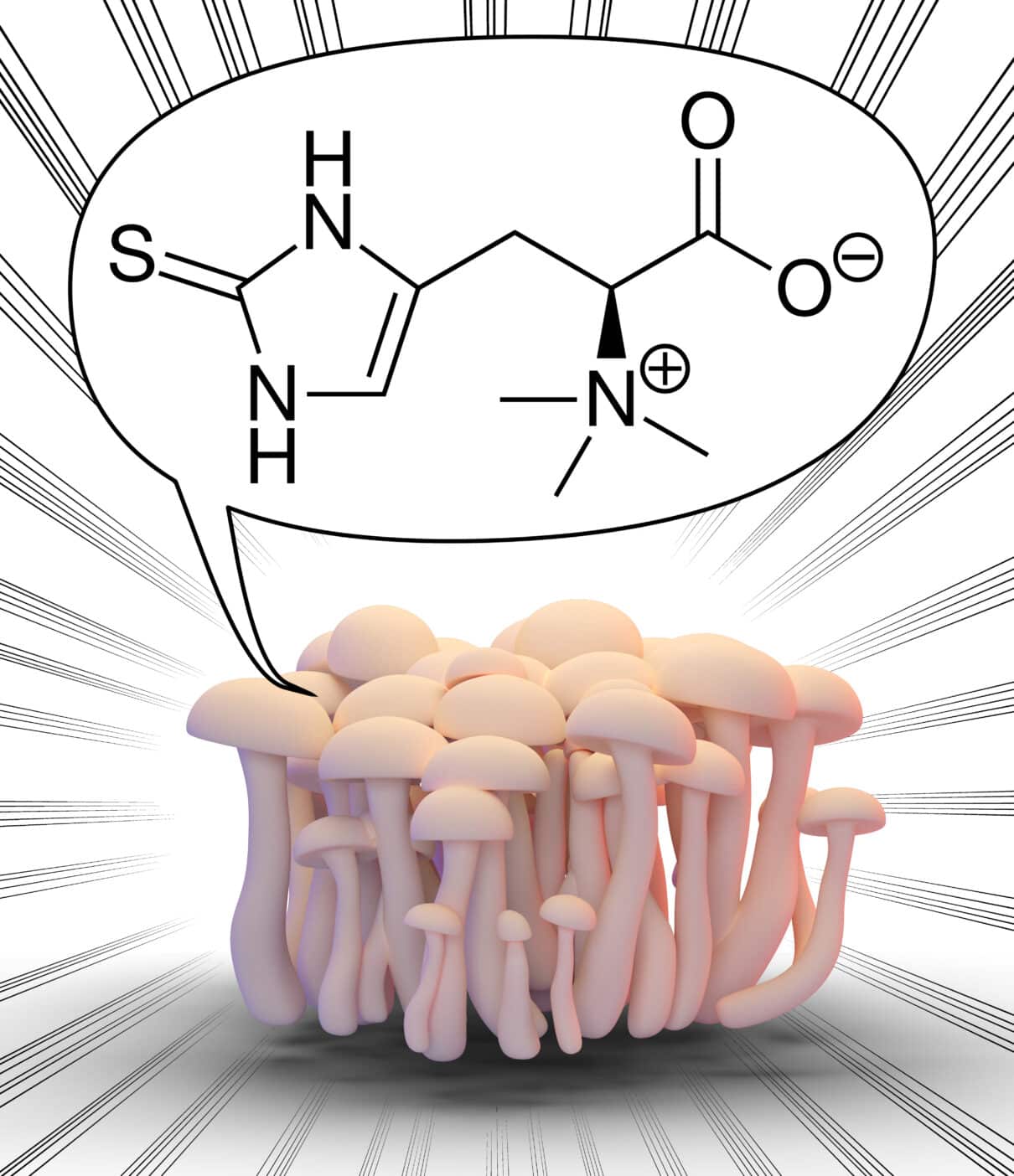Ergothioneine (EGT)

When we think of antioxidants, vitamins A, C and E and polyphenols, which are found in many berries, tomatoes and spices such as turmeric, come to mind. Ergothioneine (EGT), on the other hand, is not yet so well known, although it has an extremely positive effect. The naturally occurring amino acid was named after the ergot mushrooms from which it was first purified in 1909. Ergot mushrooms, better known to us as rye fungi, belong to the genus Claviceps. Around 50 species are known to date, which are mainly found in tropical regions. These include Claviceps purpurea (“rye ergot fungus”), Claviceps fusiformis, which attacks buffalo grass and pearl millet, and Claviceps lutea, which can be found on paspalum grasses. Ergothioneine (EGT) is relatively rare and is mainly found in other fungi such as shiitake and oyster mushrooms, the crested scorpionfish (Coprinus comatus), the orange-yellow pupa (Cordyceps militaris) as well as in cyanobacteria and actinobacteria.
Humans only consume the amino acid through food. Significant amounts are found in red peppers, broccoli, chicken liver and green beans. However, plants only absorb ergothioneine (EGT) from the soil via their roots. How high the content in a plant is therefore depends on the corresponding soil conditions. EGT is now also available as a food supplement. The European Food Safety Authority has set a safe maximum daily intake of 1.31 milligrams per kilogramme of body weight for adults. EGT is absorbed very quickly by the body and accumulates via the bloodstream in the eyes, bone marrow, liver, kidneys, seminal fluid, and erythrocytes.
The effect of ergothioneine
In its pure state, the substance is a highly water-soluble, odourless white solid. It has strong antioxidant and cell-protecting properties and counteracts oxidative stress in the cells by deactivating hypochlorous acid and hydroxyl radicals. By chelating divalent metallic cations, it can prevent the formation of radicals. The substance is also involved in metal ion transport and the regulation of metalloenzymes.
EGT also has an anti-inflammatory effect, and is able to support the effect of vitamin C in our skin, which makes the substance interesting for combined formulations, among other things. Ergothioneine (EGT) is of course officially authorised for use in cosmetic products.
A comprehensive study at Taipei Medical University has already shown how effective antioxidants such as ergothioneine (EGT) are. There, very old rats were fed with mushroom extracts. The researchers were subsequently able to observe clear protection of the internal organs against ageing.
However, not all of the positive properties of ergothioneine (EGT) have yet been confirmed in vivo. However, it seems certain that the amino acid leads to a general immunomodulation and can protect the brain from certain neurotoxins. The same applies to the protection of our skin against UV rays, which has also been proven. The effects of EGT against various inflammations and in the treatment of various diseases has already been well researched, but further studies are still pending.
Ergothioneine (EGT) in cosmetics
Ergothioneine is often valued for its powerful antioxidant properties, which can help protect the skin from the damaging effects of free radicals. Free radicals are unstable molecules produced in the environment, such as UV radiation and pollution, that can cause oxidative stress in the skin, leading to premature ageing and other skin problems. As an antioxidant, the amino acid can help neutralise these free radicals and protect the skin from oxidative stress.
Ergothioneine is also valued for its anti-inflammatory properties. It can help to soothe skin irritations and strengthen the skin barrier, which in turn can help to improve skin condition.
To summarise, we can say that ergothioneine (EGT) with its strong antioxidant effect is an ideal active ingredient for innovative anti-ageing cosmetics. It can be combined in a variety of ways, for example in day and night creams, beauty boosters and serums.
Ergothioneine (EGT) profile
INCI: Ergothioneine
CAS number: 497-30-3
EINECS: 207-843-5
Abbreviation: EGT
Definition: Thiourea derivative of histidine, non-proteinogenic amino acid
Description: white solid
Melting point: 275 to 277 degrees Celsius
Effect: strongly antioxidant and anti-inflammatory
We like to work with these EGT-containing active ingredients:
| Trade Name | Company Name | INCI | Comment |
|---|---|---|---|
| Ergothioneine | COSROMA | Ergothioneine | |
| Creapep Ergothioneine | Tidetron Bioworks | Ergothioneine | |
| Ergothioneine , Mannitol | COSROMA | Ergothioneine , Mannitol | |
| 500ppm L-Ergothioneine(EGT) Solution | Hangzhou Rebtech Novel Material Co., Ltd. | Ergothioneine , Water | |
| Bioyouth-EGT Pure Ultrapure Ergothioneine | Bloomage Biotechnology Corp., Ltd. | Ergothioneine | |
| AC-EGT | SOHO ANECO Chemicals Co., Limited | Ergothioneine | |
| WActive EGT | Shenzhen Winkey Technology Co., Ltd. | Ergothioneine | |
| AC-EGT Zero additive | SOHO ANECO Chemicals Co., Limited | Ergothioneine , Water | |
| Bioyouth-EGT | Bloomage Biotechnology Corp., Ltd. | Ergothioneine , Tricholoma Matsutake Mycelium Ferment Extract |
Ergothioneine, the secret weapon against skin ageing processes
Discovered in 1909, this substance with its impressive antioxidant and cell-protecting properties is virtually predestined for high-quality premium cosmetics. It can effectively counteract the skin’s ageing process and is very well tolerated, as it is also found in the human body when ingested with food. Cosmacon can formulate exclusive premium cosmetics with ergothioneine (EGT) for you on request.
Sources:
Ergothioneine and its prospects as an anti-ageing compound.; Exp Gerontol. 2022 Dec;170:111982.
Safe and Effective Antioxidant: The Biological Mechanism and Potential Pathways of Ergothioneine in the Skin.; Molecules. 2023 Feb 8;28(4):1648.
Construction and optimization of ergothioneine-producing Escherichia coli.; Wang L, Wang Y, Li J, DU G, Kang Z.Sheng Wu Gong Cheng Xue Bao. 2022 Feb 25;38(2):796-806
Antioxidant Properties and Industrial Uses of Edible Polyporales.; Quintero-Cabello KP, Lugo-Flores MA, Rivera-Palafox P, Silva-Espinoza BA, González-Aguilar GA, Esqueda M, Gaitán-Hernández R, Ayala-Zavala JF.J Fungi (Basel). 2021 Mar 9;7(3):196.
Recent progress in ergothioneine biosynthesis: a review; Liu Q, Mao Y, Liao X, Luo J, Ma H, Jiang W.Sheng Wu Gong Cheng Xue Bao. 2022 Apr 25;38(4):1408-1420